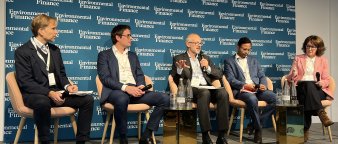Fifteen years ago, many doubted the viability of index-aware funds, but today several fund companies offer them, and the demand is significant. Kristian Håkansson, Product Manager at Storebrand Fonder in Sweden, has first-hand experience of the launching of the first index-aware fund. He shares what index-aware funds entail and why they still serve a crucial function in the market.
Can you briefly tell us what an index-aware fund is?
In short, it is a product for private savers and institutional investors who want a more sustainable index fund. To elaborate, an index-aware fund replicates an index with the exception of excluding certain companies. These are replaced by companies with a similar return pattern. For example, a tobacco company could be replaced by a consumer goods company selling everyday products like toothpaste. This is done to reduce risk and generate a good risk-adjusted return. Companies can be excluded based on product criteria such as tobacco, commercial gambling, or fossil fuels, or norm-based criteria like human rights, corruption, or serious environmental damage.
When did the first index-aware funds emerge?
Sixteen years ago, when Storebrand acquired Storebrand Fonder in Sweden (then SPP Fonder) from Handelsbanken, Storebrand wanted to exclude certain companies from index funds due to high sustainability requirements. The Financial Supervisory Authority in Sweden rejected calling the funds index funds, and two years later, in 2010, we introduced Storebrand Fonder's first index-aware fund. I
How popular are index-aware funds?
We could never have anticipated how large they would become. It started with almost explosive inflows into regular index funds. Since 2010, the proportion of index funds in the total equity fund assets has increased from 6 percent to over 20 percent at the end of 2022. When we look at index-aware funds compared to the traditional index funds, they now constitute the majority of the market in Sweden. Internationally, we still see a binary trend, meaning major fund companies offer either 'true active' or traditional index funds. However, we observe growing demand beyond borders.
What function do index-aware funds serve today?
Beyond meeting the demand from private savers and large institutional investors with ambitious sustainability goals, such as the UN Agenda for 2030, index-aware funds demonstrate how to channel capital more broadly and not just work with sustainable investments in narrower niche funds. Today, index-aware funds form a cornerstone in many investors' portfolios. Through sustainability criteria, we believe we significantly raise the baseline, instead of simply buying a broad index outright.
We also believe that index-aware funds support the overall sustainable investment strategy. The sustainable investment strategy is based on three methods to achieve global sustainability goals. These involve excluding, including, and influencing. One method does not solve everything, and we believe in combined efforts for lasting change. Index-aware funds are carrying their own weight in the sustainable investment universe by deploying exclusions.
Can index-aware funds exercise active ownership?
Contrary to the very common misconception, they can indeed. Both index funds and index-aware funds can exercise active ownership. We use our position as significant owners to influence companies for improvement by voting at meetings and engaging in dialogues, whether the holdings are in an index-aware fund or an actively managed fund. Dialogues also build relationships and create mutual trust, a prerequisite for information sharing. Even if certain companies are excluded from our investment universe, we can continue our relationship with them by further challenging them.
There are ready-made sustainability indices to follow, so why does Storebrand depart from 'regular indices' and handpick excluded companies?
That's a good question and a highly relevant one! The main reason is that our fund managers can make discretionary choices and quickly adjust the portfolio's composition. If we deem a holding controversial, our fund managers can exclude it the next day. The big advantage is simply flexibility. Our customers buy our proprietary analysis. We also think it's relevant to compare our funds to a standardized market index. Adding another product with a purchased sustainability index would not add market value. The shortcomings in ready-made indices vary, but I can provide an example. The EU-defined Paris Aligned Benchmark (PAB) has, for instance, a 7% requirement to reduce carbon dioxide emissions annually. Many want to show continuous improvement year after year, but our Swedish funds are already fossil-free, making it challenging to demonstrate such significant reductions in carbon dioxide emissions. We would be forced to buy fossil companies only to sell them at the rate dictated by the index—which makes so little sense!
Another reason is that sustainability and customized indices are more expensive to purchase, and they are paid per fund. Storebrand Fonders' signature is sustainable funds with low fees. With purchased indices, it would be impossible for us to maintain the low fees we have today.
If you could wish for any change in the fund industry, what would it be?
I want the passion for sustainable investments to return! Lately, there has been a lot about implementing regulations, which is good and necessary. But I also see that it has created many blind spots, and it seems like we've lost our excitement along the path. The term 'sustainability' has become inflated, and many are afraid of 'greenwashing.' It has contributed to 'hushwashing' instead, where many are afraid to even mention the word. But now is when we must talk even more about what we actually do, which impact dialogues have been effective, which risks we have managed to avoid. Not the least, to gain respect when we highlight the risks we want to avoid in the future.
If I may add one more thing to the wish list, it's that the Swedish Fondtorgsnämnd (Fund Marketplace Board in English) allows index-aware funds to participate in the procurement of funds on the new premium pension platform. It is one of Sweden's largest procurements; by 2040, the assets are estimated to be worth around SEK 4 trillion! It has been a bit uncertain whether index-aware funds should qualify, as returns may fluctuate due to exclusions compared to their benchmark. But here, we need to tolerate some flexibility and look at the product properties rather than the index overlapping. Otherwise, we risk going back to where we started this journey 15 years ago. Now more than ever, we must ensure that broad capital is moved towards sustainability goals!







